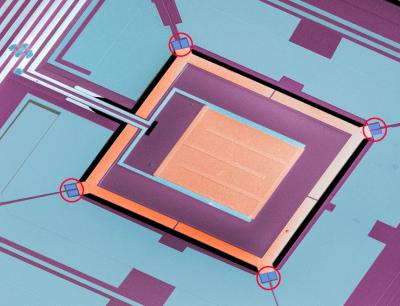Researchers at the National Institute of Standards and Technology (NIST) have combined a cryogenic sensor and a microrefrigerator on a single microchip.
They combined a transition-edge sensor (TES)(1), a superconducting thin film that identifies X-ray signatures far more precisely than any other device, with a solid-state refrigerator based on a sandwich of a normal metal, an insulator and a superconductor.
The combo chip, a square about a quarter inch on a side, achieved the first cooling of a fully functional detector (or any useful device) with a microrefrigerator. The paper also reports the greatest temperature reduction in a separate object by microrefrigerators: a temperature drop of 110 millikelvins (mK), or about a tenth of a degree Celsius.

TES sensors are most sensitive at about 100 mK (a tenth of a degree Celsius above absolute zero). However, these ultralow temperatures are usually reached only by bulky, complex refrigerators. Because the NIST chip can provide some of its own cooling, it can be combined easily with a much simpler refrigerator that starts at room temperature and cools down to about 300 mK, says lead scientist Joel Ullom. In this setup, the chip would provide the second stage of cooling from 300mK down to the operating temperature (100 mK).
One promising application is cheaper, simpler semiconductor defect analysis using X-rays. A small company is already commercializing an earlier version of TES technology for this purpose. In another application, astronomical telescopes are increasingly using TES arrays to take pictures of the early universe at millimeter wavelengths. Use of the NIST chips would lower the temperature and increase the speed at which these images could be made, Ullom says.
The work was supported in part by the National Aeronautics and Space Administration.
(1) For background on how TESs and microrefrigerators work, see “Copper Ridges Nearly Double X-ray Sensor Performance” (Tech Beat, Nov. 17, 2005), and “Chip-scale Refrigerators Cool Bulk Objects” (Tech Beat, April 21, 2005).
Article: N.A. Miller, G.C. O’Neil, J.A. Beall, G.C. Hilton, K.D. Irwin, D.R. Schmidt, L.R. Vale and J.N. Ullom. High resolution X-ray transition-edge sensor cooled by tunnel junction refrigerators. Applied Physics Letters.


